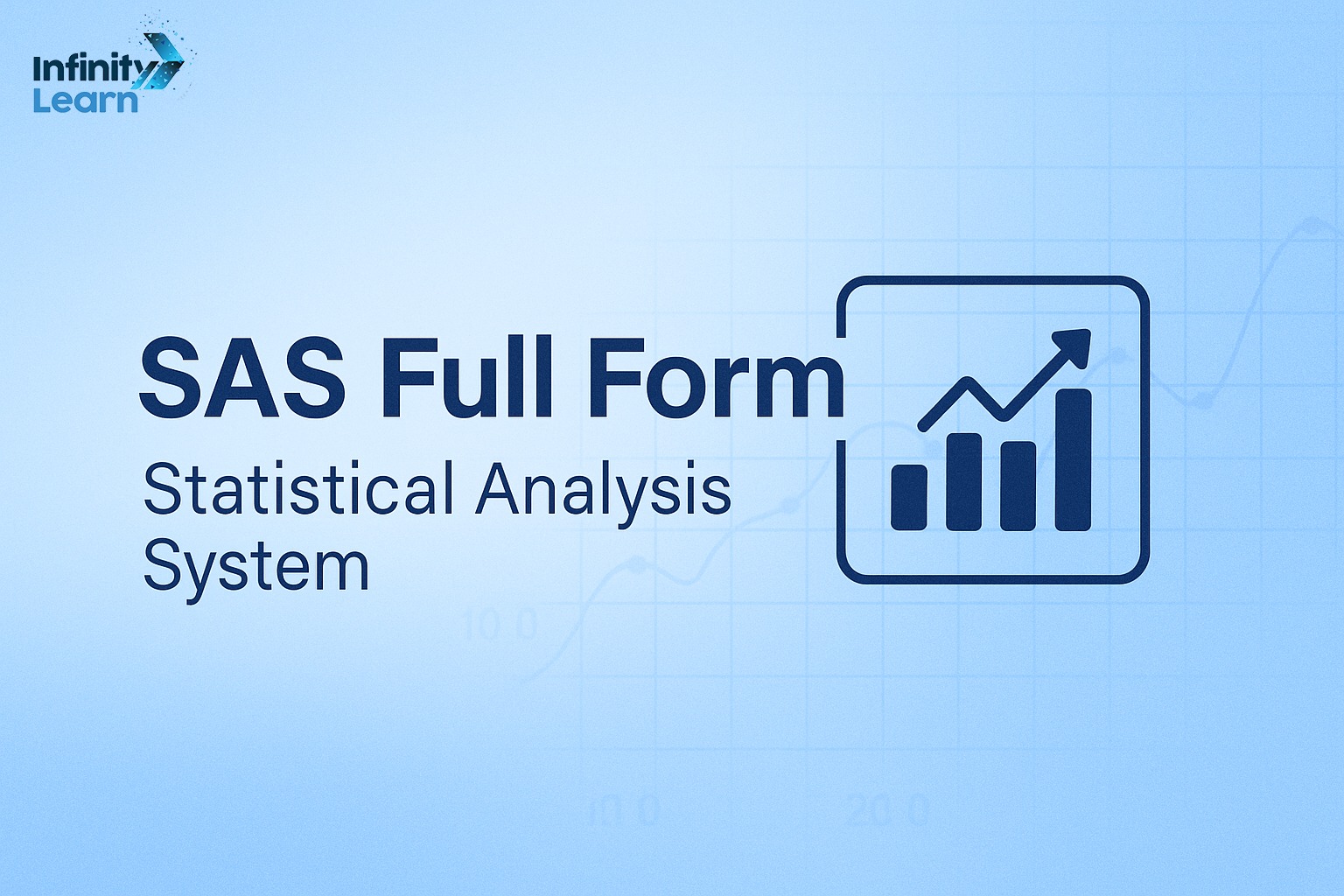Table of Contents
SAS, or Statistical Analysis System, is a robust software suite that offers advanced analytics, business intelligence, data management, and predictive analytics capabilities. Developed by SAS Institute Inc., this comprehensive system is used globally across various industries, ranging from healthcare to finance. Its primary focus is to extract meaningful insights from large datasets, allowing organizations to make data-driven decisions.
The SAS full form—Statistical Analysis System—reflects its core objective: performing statistical analysis and data manipulation. SAS plays a crucial role in sectors such as healthcare, finance, education, and market research, and it is increasingly used for tasks like data mining, predictive modeling, and more.

History and Development of SAS
The development of SAS began in 1966 when Anthony Barr, James Goodnight, John Sall, and Jane T. Helwig laid the foundation of what would become the SAS software full form. The initial objective was to provide a system for agricultural research to manage and analyze data. By 1976, SAS Institute was founded, and the software evolved to accommodate complex statistical analysis.
SAS gained traction in the 1980s and 1990s with the introduction of new statistical techniques and tools. The software’s flexibility grew with the release of the JMP platform and further enhancements, including a graphical user interface (GUI) in SAS version 9 (2004). In 2010, social media analytics were integrated into the software, further expanding its capabilities.
Today, SAS remains at the forefront of advanced analytics and data management, offering an impressive suite of tools to analyze, visualize, and report data.
Do Check: ABG Full Form
Understanding the Key Components of SAS
SAS offers a range of components that make it versatile and powerful. Here are some of the key features of SAS:
1. Solid Data Analysis Capabilities
SAS is renowned for its ability to handle large datasets and complex data analysis. The software offers a wide array of in-built libraries and packages that assist in advanced data analysis. These libraries are crucial for tasks like regression analysis, hypothesis testing, and data visualization.
2. SAS Studio
SAS Studio is a web-based interface that simplifies access to SAS functionalities from any device. Users can access their data libraries, run analyses, and generate reports, all from within their web browsers. There’s no need to install SAS on each device, making it a highly accessible tool.
3. Data Encryption and Security
Data security is a major concern in analytics, and SAS addresses this with advanced data encryption algorithms. SAS/SECURE, available in SAS 9.4, ensures the integrity and security of data by encrypting sensitive information using various encryption methods.
4. Wide Data Format Support
SAS can handle various types of data formats, including CSV, Excel, and SQL databases. The software is capable of reading and processing data from different sources, even if some records are incomplete or corrupted, ensuring data accuracy and consistency.
5. Analytics Environment Management
SAS also offers a comprehensive management system that helps administrators oversee their analytics environment. The environment manager monitors, alerts, and manages analytics workloads, ensuring smooth operations.
6. Integration with Other Tools
SAS is designed to integrate seamlessly with a range of other software and tools. It can connect to databases, statistical software, and even business intelligence tools, ensuring a smooth workflow for users across different platforms.
Do Check: ACC Full Form
SAS Full Form in Different Contexts
While the SAS full form typically stands for Statistical Analysis System, its usage varies across different fields. Below are some of the contexts in which SAS is used:
SAS Full Form in Maths
In mathematics, the term SAS often refers to the Side-Angle-Side condition, which is a principle used to determine the congruence of triangles. When two triangles have two sides and the included angle equal to two sides and the included angle of another triangle, the triangles are congruent.
However, SAS in the context of Statistical Analysis System is more widely used in data analysis and research.
SAS Full Form in Education
In the context of education, SAS stands for Statistical Analysis System, which is used for educational research and analysis. Schools, universities, and educational institutions use SAS to analyze student performance, survey results, and other academic data. By analyzing such data, educational institutions can gain insights into student behavior, curriculum effectiveness, and other important metrics.
SAS software is commonly employed by researchers in education to conduct studies and prepare reports on a variety of topics ranging from student success rates to faculty performance.
Do Check: ADB Full Form
Features and Benefits of SAS
The versatility and reliability of SAS are why it remains one of the most widely used tools in data analytics today. Below are some notable features and benefits of using SAS:
Easy-to-Learn Syntax
One of the reasons for SAS’s widespread use is its ease of learning. Unlike other statistical software, SAS offers a relatively simple syntax, making it accessible to both novice and experienced users. Even those without a programming background can learn how to use SAS effectively.
Scalability
SAS is capable of handling large datasets with ease, making it ideal for organizations that deal with vast amounts of data. The software can scale to meet the needs of small businesses as well as large enterprises.
Reliable Reporting and Analytics
SAS has been trusted by thousands of companies for its accurate and reliable reporting tools. From clinical trials to marketing analytics, SAS provides detailed, accurate reports that help businesses make data-driven decisions.
Advanced Statistical Techniques
SAS includes a wide variety of statistical techniques such as regression, analysis of variance (ANOVA), hypothesis testing, and multivariate analysis. These tools allow users to perform sophisticated analyses and obtain actionable insights.
Robust Data Management Capabilities
SAS is known for its robust data management capabilities. It can clean, sort, and prepare data for analysis efficiently, ensuring that the final analysis is accurate and reliable.
Data Visualization Tools
SAS offers powerful data visualization tools that allow users to create clear, interactive visualizations to present their findings. These include graphs, charts, and dashboards that help communicate complex data to stakeholders effectively.
Do Check: AICTE Full Form
SAS Applications in Various Industries
SAS’s diverse functionalities make it applicable across various industries. Some key applications include:
Healthcare
In healthcare, SAS is used to analyze clinical trial data, ensuring compliance with regulatory standards. It helps researchers identify trends in patient outcomes and perform risk assessments.
Finance
In finance, SAS is used for predictive analytics, such as forecasting stock trends, detecting fraud, and assessing credit risk. Financial institutions rely on SAS’s powerful tools to analyze large datasets and identify potential risks.
Education
SAS is widely used in educational institutions for research purposes, student performance analysis, and curriculum development. It helps in understanding learning trends, measuring educational outcomes, and improving teaching strategies.
Marketing and Retail
Marketing agencies and retail businesses use SAS to analyze consumer behavior, optimize pricing strategies, and personalize marketing campaigns. By analyzing purchase patterns and customer feedback, businesses can improve customer satisfaction and increase sales.
Government and Public Sector
SAS is used by government agencies for tasks such as crime analysis, census data processing, and public health monitoring. The software helps policymakers make informed decisions based on solid data insights.
Also Check: ENT Full Form
SAS vs. Other Statistical Software
While SAS is a powerful tool, there are several other software packages available that offer similar functionality, including R, Python, and SPSS. Below is a comparison between SAS and some of these alternatives:
| Feature | SAS | R | Python | SPSS |
| Ease of Use | Easy-to-learn with a simple syntax | Requires some programming | Requires programming skills | User-friendly interface |
| Data Handling | Handles large datasets efficiently | Efficient with data frames | Efficient with large datasets | Less efficient with large datasets |
| Graphics | Limited in comparison to R | Powerful graphics capabilities | Powerful graphics capabilities | Limited graphics options |
| Community Support | Extensive commercial support | Strong open-source community | Strong open-source community | Strong support in academia |
| Cost | Expensive (requires a license) | Free and open-source | Free and open-source | Expensive (requires a license) |
Conclusion
In conclusion, SAS stands for Statistical Analysis System, and it is a critical tool for businesses, researchers, and analysts worldwide. The software’s ability to perform complex statistical analyses, manage large datasets, and produce actionable insights makes it invaluable across industries like healthcare, finance, education, and more.
While SAS’s commercial nature and high cost may be a barrier for some, its power and versatility make it an essential tool for many large-scale organizations and institutions. Whether for predicting trends, analyzing customer behavior, or performing research, SAS continues to lead the way in data analytics and business intelligence.
FAQs on SAS Full Form
What is the full form of SAS?
The full form of SAS is Statistical Analysis System. It is a powerful software suite developed by SAS Institute Inc. for advanced analytics, business intelligence, data management, and predictive analytics. SAS is widely used for statistical analysis and data-driven decision-making in various industries such as healthcare, finance, and education.
What does SAS stand for in math?
In mathematics, SAS stands for Side-Angle-Side. It is a condition used to prove the congruence of two triangles. If two sides and the included angle of one triangle are equal to two sides and the included angle of another triangle, the triangles are congruent by the SAS postulate.
How does SAS software work?
SAS software works by using its built-in libraries and data analysis functions to process large datasets, perform statistical analysis, and generate reports. Users can input their data into SAS, apply various statistical methods, and then use SAS to interpret and visualize the results. The software also supports predictive analytics and can handle data from multiple formats and sources.
What are the key features of SAS?
Some key features of SAS include: Data Management: Efficient handling of large datasets from multiple sources. Advanced Analytics: Tools for statistical analysis, predictive modeling, and data mining. Data Visualization: Powerful graphing and charting tools to present data clearly. Security and Encryption: Built-in algorithms to ensure the security of sensitive data. Extensive Libraries: Pre-built libraries for various analytical techniques, making it easy for users to perform advanced analysis.
How is SAS used in education?
In education, SAS (Statistical Analysis System) is used for conducting research, analyzing student performance, and improving curriculum. Educational institutions use SAS to gain insights from student data, such as exam results and survey responses, to make informed decisions and improve the learning experience.
What is the difference between SAS and other statistical tools like R or SPSS?
While SAS, R, and SPSS are all statistical analysis tools, they differ in several ways: SAS is known for its powerful data management and analytics capabilities, though it requires a paid license. R is open-source and provides powerful statistical and graphical tools, with a strong programming base. SPSS is user-friendly and often used in academic settings for basic statistical analysis but lacks some of the advanced features of SAS and R. SAS is often preferred in corporate and regulatory environments due to its comprehensive support and high-level functionality.









